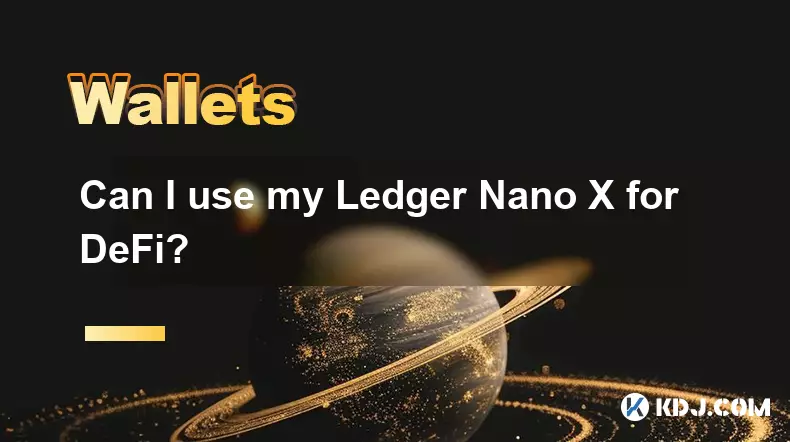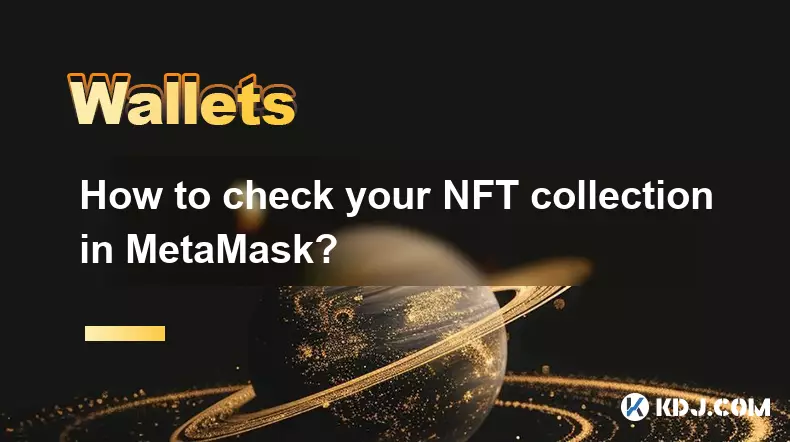-
 bitcoin
bitcoin $105968.894684 USD
4.17% -
 ethereum
ethereum $3639.320047 USD
7.62% -
 tether
tether $1.000339 USD
0.06% -
 xrp
xrp $2.407774 USD
5.96% -
 bnb
bnb $1011.704193 USD
2.28% -
 solana
solana $166.942754 USD
6.37% -
 usd-coin
usd-coin $1.000143 USD
0.03% -
 tron
tron $0.291515 USD
0.25% -
 dogecoin
dogecoin $0.181682 USD
4.06% -
 cardano
cardano $0.585450 USD
4.54% -
 hyperliquid
hyperliquid $42.099968 USD
5.20% -
 chainlink
chainlink $16.160745 USD
5.45% -
 zcash
zcash $645.269648 USD
12.96% -
 bitcoin-cash
bitcoin-cash $507.430338 USD
2.80% -
 stellar
stellar $0.290357 USD
3.69%
Can I use my Ledger Nano X for DeFi?
The Ledger Nano X enhances DeFi security by keeping private keys offline while enabling safe interactions with platforms like Uniswap and Aave via MetaMask or WalletConnect.
Oct 31, 2025 at 02:18 pm

Using Ledger Nano X in the DeFi Ecosystem
1. The Ledger Nano X is a hardware wallet designed to securely store private keys for cryptocurrencies. It supports a wide range of blockchain networks, including Ethereum, Binance Smart Chain, and others that host decentralized finance (DeFi) applications. By keeping private keys offline, it significantly reduces exposure to online threats such as phishing and malware.
2. Users can interact with DeFi platforms like Uniswap, Aave, and Compound by connecting their Ledger Nano X to web-based interfaces through browser extensions such as MetaMask. When initiating transactions, the device requires physical confirmation, ensuring that no unauthorized operations are executed even if the connected computer is compromised.
3. The integration process involves installing the Ledger Live app, adding supported crypto accounts, and then linking the wallet to decentralized applications via WalletConnect or USB. This setup allows users to provide liquidity, stake tokens, borrow assets, or trade directly from secure hardware-backed addresses.
4. One major advantage is the separation between fund storage and transaction signing. While DeFi interactions occur on public blockchains, the actual signing happens within the secure element of the Ledger device. This architecture maintains control over assets without sacrificing accessibility to open financial protocols.
5. Firmware updates released by Ledger regularly enhance compatibility with emerging DeFi standards and token types. These updates ensure continued support for new ERC-20 tokens, governance mechanisms, and yield farming contracts, enabling long-term participation in evolving ecosystems.
Security Considerations When Connecting to DeFi Platforms
1. Even though the Ledger Nano X protects private keys, users must remain cautious about the websites they connect to. Fake versions of popular DeFi sites can trick individuals into approving malicious transactions. Always verify URLs and use bookmarks for trusted dApps.
2. Phishing attacks often mimic legitimate smart contract approvals. Before confirming any token allowance or spending limit on the Ledger device screen, carefully review the contract address and requested permissions. An unusually high allowance could indicate a potential risk.
3. Malware on the host system may intercept data during transaction preparation. Although the signed data remains secure, incorrect parameters might be displayed on the Ledger screen. Running up-to-date antivirus software and avoiding suspicious downloads minimizes this threat surface.
4. Some DeFi platforms require multiple steps involving several contract calls. Each action needs individual approval on the device. Users should understand the sequence of operations they are authorizing and avoid rushing through confirmations.
5. Never share recovery phrases or PIN codes under any circumstances. Scammers may pose as customer support agents from DeFi projects or Ledger itself to extract sensitive information.
Managing Multiple Assets Across Networks
1. The Ledger Nano X supports over 5,000 digital assets across various chains. This versatility allows users to manage ETH, MATIC, AVAX, and other tokens used in different DeFi environments from a single interface.
2. Switching between networks in MetaMask or similar wallets requires manual selection, but once configured, the Ledger seamlessly signs transactions for each chain. Proper network configuration prevents funds from being sent to incompatible addresses.
3. Cross-chain bridges have become integral to DeFi strategies. With Ledger protection, users can move assets between ecosystems like Ethereum and Arbitrum while maintaining hardware-level security during signing processes.
4. Token detection settings in wallet software should be reviewed periodically. New tokens received through yield farming or airdrops may not appear immediately, but they remain accessible as long as the underlying account is controlled by the Ledger.
5. Regularly audit active token allowances using tools like Revoke.cash. Removing unused permissions reduces attack vectors even when using a secure hardware wallet.
Frequently Asked Questions
Can I stake Ethereum directly through my Ledger Nano X?Yes, you can stake Ethereum using services integrated with Ledger Live, such as Lido or Coinhouse. The staking process uses your ETH while keeping private keys secured on the device. Rewards are credited to your wallet address and can be monitored through the same interface.
What should I do if my Ledger Nano X doesn’t show up in MetaMask?Ensure the correct Ethereum app is open on the device, USB debugging is enabled, and the latest firmware is installed. Try restarting both MetaMask and Ledger Live, and test with a different USB cable or port. Browser compatibility issues may also require switching to Chrome or Firefox.
Is it safe to use WalletConnect with Ledger for DeFi?Yes, WalletConnect establishes an encrypted bridge between mobile apps and hardware wallets. When pairing via QR code, verify the connection originates from an official app. Once linked, transaction confirmations still require explicit approval on the Ledger device, preserving security.
Can someone hack my DeFi positions if they only have my wallet address?No. Public wallet addresses are designed to be shared and only reveal transaction history. Without access to private keys—securely stored on the Ledger Nano X—no one can withdraw funds or alter active positions, regardless of how much visibility they have into your activity.
Disclaimer:info@kdj.com
The information provided is not trading advice. kdj.com does not assume any responsibility for any investments made based on the information provided in this article. Cryptocurrencies are highly volatile and it is highly recommended that you invest with caution after thorough research!
If you believe that the content used on this website infringes your copyright, please contact us immediately (info@kdj.com) and we will delete it promptly.
- Ripple (XRP) in 2026: Hold or Fold? A Look at XRP's Future and Emerging DeFi Alternatives
- 2025-11-08 18:35:01
- Zcash ZEC Coin Price Explosion: From Privacy Niche to Center Stage
- 2025-11-08 18:55:01
- Berachain Price Prediction: Navigating the Honeycomb Hype in Crypto
- 2025-11-08 18:55:01
- Arthur Hayes, Gold, and Bitcoin: A Modern Monetary Trinity?
- 2025-11-08 19:15:01
- Shiba Inu's Next Move: Navigating a Shifting Market
- 2025-11-08 19:20:01
- Pakistan's Crypto Crossroads: Balancing Opportunity with Asset-Backed Realities
- 2025-11-08 19:20:01
Related knowledge

How to use MetaMask Portfolio to track assets?
Nov 08,2025 at 05:40am
Getting Started with MetaMask Portfolio1. Download and install the MetaMask mobile app from the App Store or Google Play. Open the app and select 'Imp...

MetaMask not popping up: how to fix this issue?
Nov 10,2025 at 05:59am
Understanding the MetaMask Pop-Up Issue1. MetaMask is one of the most widely used cryptocurrency wallets, especially for interacting with decentralize...

How to send ETH from Binance to MetaMask?
Nov 10,2025 at 04:40am
Sending ETH from Binance to MetaMask: A Step-by-Step GuideTransferring Ethereum (ETH) from your Binance account to your MetaMask wallet is a common op...

How to check your NFT collection in MetaMask?
Nov 06,2025 at 08:20pm
Accessing Your NFTs in MetaMask Wallet1. Open the MetaMask browser extension or mobile app and ensure you are logged into your wallet account. Once in...

Why is the MetaMask swap feature failing?
Nov 06,2025 at 09:20pm
Understanding MetaMask Swap FailuresMetaMask, one of the most widely used cryptocurrency wallets, enables users to swap tokens directly within the int...

How to update the MetaMask extension in Chrome?
Nov 08,2025 at 07:39am
Updating the MetaMask extension in Chrome is a simple process that ensures you have access to the latest security features, performance improvements, ...

How to use MetaMask Portfolio to track assets?
Nov 08,2025 at 05:40am
Getting Started with MetaMask Portfolio1. Download and install the MetaMask mobile app from the App Store or Google Play. Open the app and select 'Imp...

MetaMask not popping up: how to fix this issue?
Nov 10,2025 at 05:59am
Understanding the MetaMask Pop-Up Issue1. MetaMask is one of the most widely used cryptocurrency wallets, especially for interacting with decentralize...

How to send ETH from Binance to MetaMask?
Nov 10,2025 at 04:40am
Sending ETH from Binance to MetaMask: A Step-by-Step GuideTransferring Ethereum (ETH) from your Binance account to your MetaMask wallet is a common op...

How to check your NFT collection in MetaMask?
Nov 06,2025 at 08:20pm
Accessing Your NFTs in MetaMask Wallet1. Open the MetaMask browser extension or mobile app and ensure you are logged into your wallet account. Once in...

Why is the MetaMask swap feature failing?
Nov 06,2025 at 09:20pm
Understanding MetaMask Swap FailuresMetaMask, one of the most widely used cryptocurrency wallets, enables users to swap tokens directly within the int...

How to update the MetaMask extension in Chrome?
Nov 08,2025 at 07:39am
Updating the MetaMask extension in Chrome is a simple process that ensures you have access to the latest security features, performance improvements, ...
See all articles





















![The Graph Price Prediction [GRT Crypto Price News Today] The Graph Price Prediction [GRT Crypto Price News Today]](/uploads/2025/11/07/cryptocurrencies-news/videos/690d4df44fe69_image_500_375.webp)




















































